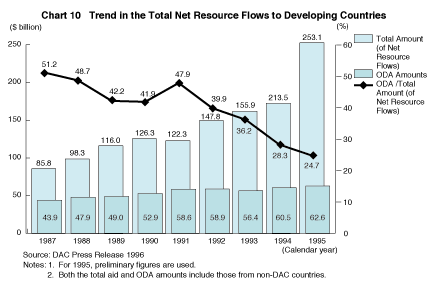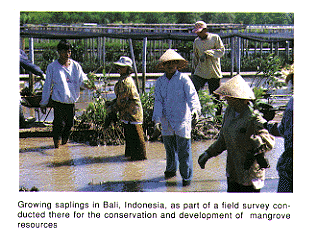Official Development Assistance (ODA)
9. Japan's Approaches to Foreign Aid
(1) Individual Approach
- Least developed countries (LDC): A major part of Japan's ODA to these countries is provided in the form of grant aid and technical assistance which impose no obligations on recipient countries to repay. And these aid funds are directed primarily to humanitarian aid and basic human needs (BHN) projects. To certain countries, however, grant aid funds are made available to finance the development of economic infrastructure.
- Countries with a relatively low per-capita GNP ($1,395 or less in 1994), such as the Philippines and Indonesia: Japan provides grant aid and technical cooperation to help implement the social sector and human resources development projects. In addition, ODA loans are made available to help build economic and social infrastructure.
- Countries with a relatively high per-capita GNP ($1,396 - $2,895), such as Thailand and Turkey: In principle, grant aid is not given to these countries, but ODA loans are extended to help them finance the construction of economic and social infrastructure. Technical cooperation is also provided for human resources development according to their development stages.
- Countries whose economic development has reached a certain level (with a per-capita GNP $2,896 or more), such as Malaysia, Mexico, and Brazil: Aware that these countries have access to private funds for the purpose of financing development projects, Japan makes its ODA loans available only to certain areas of projects such as the preservation of the environment. In addition, Japan transfers advanced technologies through technical cooperation.
(2) Comprehensive Approach: Combining ODA with Private Money flows
In order to encourage economic development in developing countries, it is important to take a comprehensive approach which includes trade and foreign direct investment as well as ODA. ODA should finance economic infrastructure which will facilitate the flow of trade and private investment.
(3) The Balance between Economic Development and Social Development
What is important in implementing aid projects is to maintain a good balance between economic development and social development (health and medical care and education, etc.). Such a balance should be directed to the promotion of human development, as is asserted in the idea of "people-centered development."


